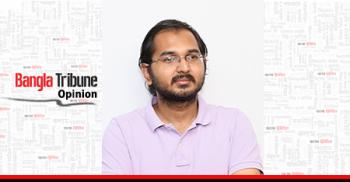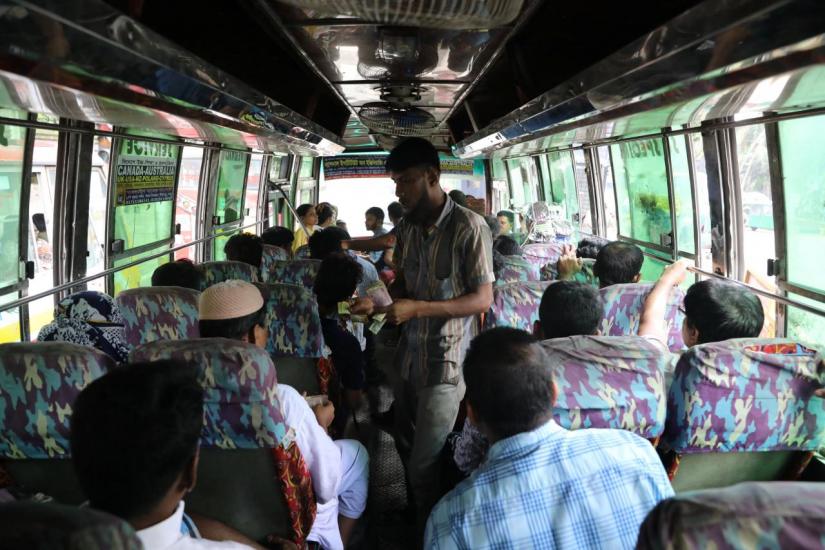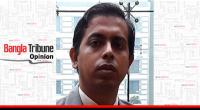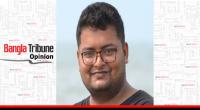 Dhaka is probably one of the very few megacities in the world without any properly planned design or guideline for the operation or expansion of the public transport system. Some other cities can be named in the same category, such as Lagos, Karachi and Kinshasa, but none has a population density of about 43,000 or probably 50,000 people per square kilometre!
Dhaka is probably one of the very few megacities in the world without any properly planned design or guideline for the operation or expansion of the public transport system. Some other cities can be named in the same category, such as Lagos, Karachi and Kinshasa, but none has a population density of about 43,000 or probably 50,000 people per square kilometre!
Present Situation
The present public transport system in Dhaka city consists of only conventional bus services (buses and minibuses) and para-transit vehicles (e.g. rickshaws, auto-rickshaws, taxis, battery bikes etc.). Lack of effective public transport system and preference of door to door service influence the planning for private car movement and another modal shifting. The Railways were very popular and are a relatively safer and cheaper system in the context of Bangladesh. But thanks to an absence of proper initiatives and a lack of investment in the urban corridors, it could not play its expected role in Dhaka’s public transport system.
There are altogether 366 bus routes in Dhaka which falsely provide the information that the city is crisscrossed by them, serving the users quite well. But actually there are unnecessary and avoidable overlapping of the routes, with the sole intention of profit maximization and securing operational advantages. Also, there are certain points and areas in the city which are lucrative for the operators. So, whatever the route, the operators always try to access those points.
Also in Dhaka, buses plying on a route are not usually owned by a single person or entity. Rather, a good number of individuals own just a single vehicle or maybe a few buses. Generally, they make a group, coming together to form a company. In some cases, they might just use the company banner for the permit, and run the buses like an individual taxi, CNG or rented car without maintaining any schedule or proper fare system. As a result, their buses ply on the roads like individually owned vehicles and create chaos. The unhealthy competition on the streets for picking up passengers, overspeeding, reckless driving etc. among the bus operators are rampant. The Consequences
The Consequences
Such factors create a situation where cars and motorcycles are becoming increasingly a necessity for the middle class, to move around in Dhaka. As a result, there is increasing congestion on the roads and greater air pollution, noise, and more safety problems. The number of registered motorized vehicles stands at 1,255,402 in April 2018 increasing from 303,215 in 2003 (a fourfold increase in 15 years). Also, more than 36% of all registered vehicles are in Dhaka (total 3,419,884 in Bangladesh) (BRTA, 2012; BRTA, 2018).
One alarming trend is that, while the percentage of buses and minibuses remain almost the same in the motorized vehicle fleet of Dhaka, the number of private vehicles, particularly cars and motorcycles, almost tripled during the same period. Public transport such as buses and minibuses increased very slowly even though the demand for public transport services rose sharply. Motorcycles and cars constitute around 54% and 26% of total motorized vehicles respectively.
As a result, the city suffers from critical and ever-deteriorating traffic congestion, despite a low level of motorization, largely due to the lack of adequate road space, deficient road network configuration and inefficient traffic management (JBIC, 2000). The average travel speed is 6.4km/hour in the city (source: The World Bank, 2017) and the annual loss is between Tk 200 billion and Tk 550 billion, due to traffic congestion (Source: ARI, BUET). According to the WHO, the city’s air is ranked 3rd among the world's most polluted.
The rise of private transport and current prevalence of NMTs (Non-Motorized Traffic, mostly rickshaws) is not a sustainable solution although they may help to increase mobility in the short term. Probably, like other properly planned and developed cities around the world, NMT movement will be restricted in the near future for Dhaka too. Hence, for transportation equity and accessibility, not only public transit is necessary but also Mass Rapid Transit (MRT) (e.g. subway, BRT, LRT, etc.) systems are urgently required and we hope that the ongoing projects of MRT and BRT will help to ease the present horrendous situation.
The writer is a consultant for Urban Public Transport Projects at the Dhaka Transport Coordination Authority (DTCA).
 Opinion
Opinion
41270 hour(s) 17 minute(s) ago ;
Morning 09:11 ; Wednesday ; Jul 02, 2025
Dhaka’s worsening public transport system
Send
Dhrubo Alam
Published : 16:09, Dec 03, 2019 | Updated : 17:42, Dec 04, 2019
Published : 16:09, Dec 03, 2019 | Updated : 17:42, Dec 04, 2019
0 ...0 ...
/ab/pdn/
Topics: Dhrubo Alam
***The opinions, beliefs and viewpoints expressed in this article are those of the author and do not reflect the opinions and views of Bangla Tribune.
- KOICA donates medical supplies to BSMMU
- 5 more flights to take back British nationals to London
- Covid19: Rajarbagh, Mohammadpur worst affected
- Momen joins UN solidarity song over COVID-19 combat
- Covid-19: OIC to hold special meeting
- WFP begins food distribution in Cox’s Bazar
- WFP begins food distribution in Cox’s Bazar
- 290 return home to Australia
- Third charter flight for US citizens to return home
- Dhaka proposes to postpone D8 Summit
Unauthorized use of news, image, information, etc published by Bangla Tribune is punishable by copyright law. Appropriate legal steps will be taken by the management against any person or body that infringes those laws.
Bangla Tribune is one of the most revered online newspapers in Bangladesh, due to its reputation of neutral coverage and incisive analysis.
F R Tower, 8/C Panthapath, Shukrabad, Dhaka-1207 | Phone: 58151324; 58151326, Fax: 58151329 | Mob: 01730794527, 01730794528


